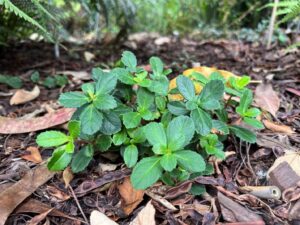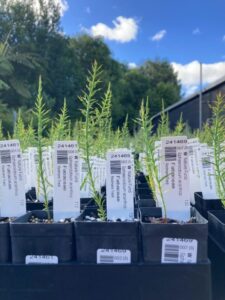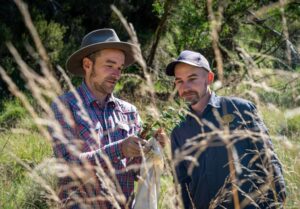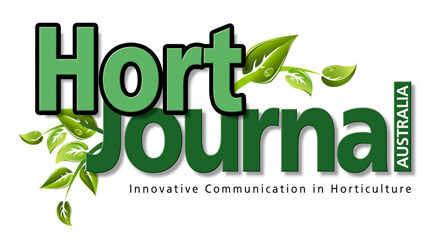
The high preservation value of conservation horticulture
By Dr. Megan Hirst and Holden Sayers
Conservation Horticulture is an important discipline driven by botanic gardens working towards global strategies to address plant conservation, with an emphasis on ex-situ living plant collections of high preservation value. The role brings together the ecology of a species with horticultural techniques to successfully propagate and provide plant material for ex-situ living collections, reintroduction, or more broadly, cultivation.
It is not a new role (Affolter 1997), but an increasingly important one, as we address plant conservation strategies and extinction risk of native flora (Meyer et al 2024). The role of Conservation Horticulturists is unique in that it works with wild populations outside of their natural range. Unlike positions such as Park Rangers or Threatened Species Officers who work closely with plants within their natural setting, an ex-situ living collection is held in an artificial environment (e.g., nursery benches in a shade house), and is created to safeguard species outside their natural range. This may involve multiple populations from the same threatened species and therefore involve considerable allocation of space. The role is not caring for one or two rare potted plants down the back of the nursery. It is an integral position working within a conservation strategy involving the management of multiple accessions of a threatened species to capture the genetic diversity and integrity of the target species. This work can be applied across multiple rare and threatened species, or populations of each, with their own unique requirements. Therefore, an understanding of the ecology and distribution of the species is fundamental to developing an ex-situ growing protocol for the threatened species involved.

What is involved?
Propagation
Propagating threatened species often means working with limited plant material (e.g., seed and/or cutting material), which stands in stark contrast to general nursery production. A considered and careful approach is required to maximise propagation success, so when conducting rigorous experiments to evaluate techniques and responses, it is critically important to conserve the limited germplasm available to work with. Drawing on the experience of respected growers, seed ecologists and nursery colleagues (and many others!) as well as referring to published work on more common congeneric species, can help fill the knowledge gaps and make the best use of the material at hand. Once an ex-situ growing protocol is established, incorporating relevant information such as any genetic work undertaken may help to identify important source populations for ex-situ conservation and inform which population/s to source and grow from to maximise the species diversity within the ex-situ collection.
Collection management
Given the time and effort invested in growing ex-situ collections, it is vital that their identity is not compromised, for example through pooling of propagation material from distinct and potentially important populations, especially if multiple populations need to be maintained. The Royal Botanic Gardens Victoria (RBGV) Living Plant Collections Database (LPCDB) assigns a unique six-digit accession number and is associated with an electronic record that includes provenance details, propagation techniques and a unique identifier for each successfully produced individual plant. All key data fields are printed on adhesive labels and plant tags remain with each individual plant for ease of identification and to avoid mixing populations (if necessary).
[JH1] Ex-situ living collections may also be planted out, for example within a botanic garden. To identify and locate these plants in the landscape, a mapping system is required, such as a base map and a 10 m2 Australian Map Grid (AMG). The RBGV uses an alphanumeric code to record the location of a plant within a 10m2 grid. Once a plant is recorded and mapped, its grid square appears red and is overlayed on a digital map on the public plant census. An aluminum plant tag is produced and accompanies every planting. Each tag includes the unique accession number, species name, family, wild status, and grid reference.

Conservation horticulture in action
An example of astrong candidate to assess conservation horticultural methods is Wittsteinia vacciniacea (Baw-Baw Berry), a vulnerable FFG listed Victorian endemic with a limited distribution to a few mountainous areas. Fire frequency and intensity have been deemed high risks for the Baw-Baw Berry, as it has no effective post fire response strategies. The risk is compounded by the added likelihood of the habitat becoming too dry. To develop an ex-situ protocol, five of the six known localities were accessed and cutting material collected. The only locality that was fruiting was at the largest population on Mt Baw-Baw, so all germination work was from that locality only. Two common nursery methods were evaluated using the cutting material under glasshouse conditions. Overall, there was a 60.8% root initiation irrespective of which media the cuttings were grown in or whether a rooting hormone was applied. We tested germination and found the Baw-Baw Berry can germinate between 8°C to 22°C, with an optimal germination temperature of about 15°C. These findings are now the basis for the ex-situ growing protocol for this species and can be used to inform curators of its cultivation requirements. Knowing we can propagate this species using seed or vegetative material, we can keep representative populations alive in containers as well as garden beds.
Looking ahead
It takes a collaborative effort to effectively hold ex-situ living collections of plant species with high conservation value. Continued monitoring of in-situ populations of threatened plants is critical to determine if any changes in habitat quality have occurred across its natural range, and can inform the strategic actions required to further safeguard and conserve. Now, more than ever before, we need the critical work of Conservation Horticulturists to strengthen and disseminate findings, establish ex-situ growing protocols and produce cultivation notes for critically endangered species. The role is of high preservation value safeguarding the long-term ex-situ insurance populations, growing plants for future reintroductions, and supporting further research. Therefore, we need to acknowledge and fund these pivotal conservation positions accordingly.
References
Affolter, J. M. (1997). Essential Role of Horticulture in Rare Plant Conservation. HortScience. 32(1):29-34.
Meyer, A., Bruns, E., Foster, J., Mims, R., and Toppila, R. (2024) Conservation Horticulture Expertise at Botanic Gardens. BGCI-US, San Marino USA.
Williamson, V. G., Rendall, A. R., Wu L, Hirst, M. J. (2024). Bringing Australia’s vulnerable Wittsteinia vacciniacea F.Muell. (Baw-Baw berry) into cultivation, Sibbaldia: The International Journal of Botanic Garden Horticulture, (23). doi:10.24823/Sibbaldia.2024.2036.
Acknowledgements
Thank you to our RBGV colleagues for all their amazing conservation work, especially our large collaborative project Preventing the extinction of Victoria’s threatened flora. Meg would like to thank her coauthors Viriginia Williamson, Anthony Rendall, and Li-Hsin Wu on the research Bringing Australia’s vulnerable Wittsteinia vacciniacea F. Muell. (Baw-Baw berry) into cultivation which assessed conservation horticulture methods.
[JH1] This entire paragraph is provided as the caption for one of the images. It is also provided in its entirety in the paragraph above.
